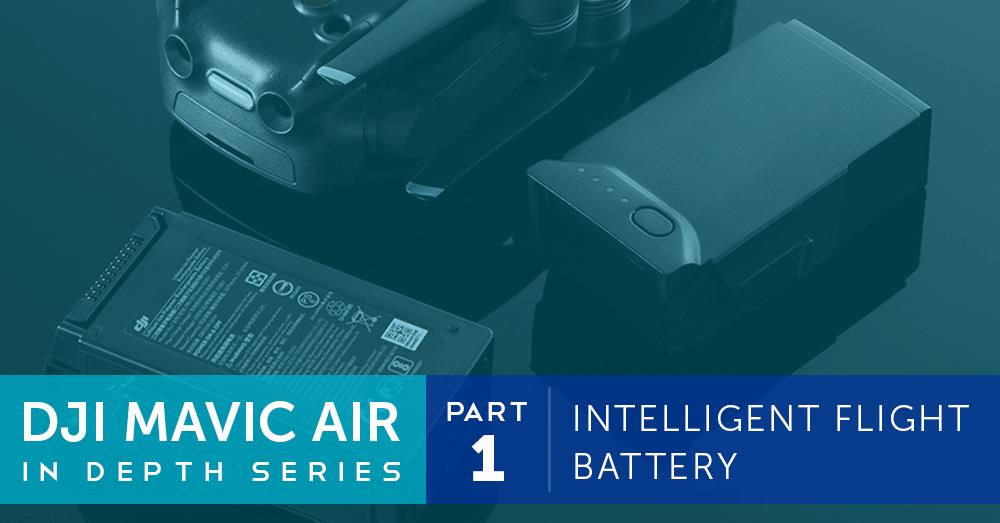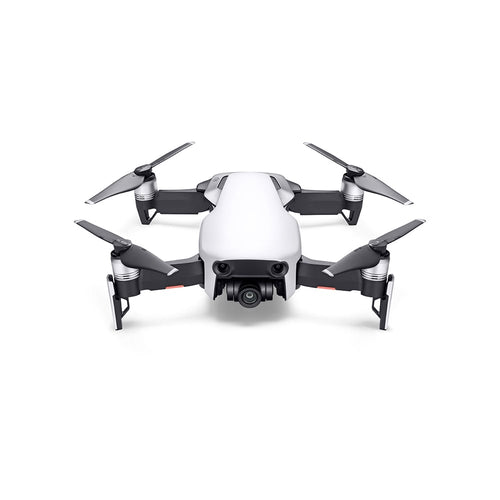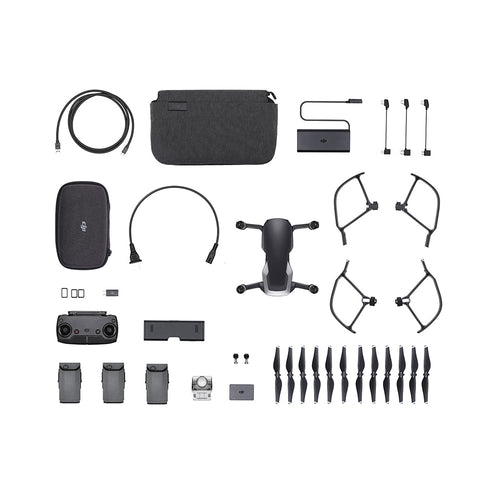 DJI Mavic Air in Depth Series – Part 1 - Intelligent Flight Battery At the end of January 2018, DJI released their revolutionary new quadcopter; the Mavic Air. Falling between the Spark and the Mavic Pro, the Mavic Air is a remarkable aircraft due to its size, power and all-round capability. It’s an extraordinary aircraft for the consumer market, that can be taken anywhere. Like our previous series of in-depth articles on the Inspire 2, heliguy™ Insider will be taking a comprehensive look at the Mavic Air’s key features, giving customers a greater insight into this new drone. We will be starting by looking at the Intelligent Flight Battery of the Mavic Air and its compatible chargers. Keep reading to find out the key features of the battery and chargers.
DJI Mavic Air in Depth Series – Part 1 - Intelligent Flight Battery At the end of January 2018, DJI released their revolutionary new quadcopter; the Mavic Air. Falling between the Spark and the Mavic Pro, the Mavic Air is a remarkable aircraft due to its size, power and all-round capability. It’s an extraordinary aircraft for the consumer market, that can be taken anywhere. Like our previous series of in-depth articles on the Inspire 2, heliguy™ Insider will be taking a comprehensive look at the Mavic Air’s key features, giving customers a greater insight into this new drone. We will be starting by looking at the Intelligent Flight Battery of the Mavic Air and its compatible chargers. Keep reading to find out the key features of the battery and chargers.  DJI Mavic Air Battery
DJI Mavic Air Battery
Specifications
Take a look at the specifications of the Mavic Air Intelligent Flight Battery and the chargers.Intelligent Flight Battery
Capacity |
2375 mAh |
Voltage |
11.55 V |
Max Charging Voltage |
13.2 V |
Battery Type |
LiPo 3S |
Energy |
27.43 Wh |
Net Weight |
140 g |
Charging Temperature Range |
5°C - 40°C |
Max Charging Power |
60 W |
Charger
Input |
100 - 240 V, 50/60 Hz, 1.4 A |
Output |
Main: 13.2 V ⎓ 3.79 A; USB: 5 V ⎓ 2 A |
Voltage |
13.2 V |
Rated Power |
50 W |
Battery
The Mavic Air battery is a high-density lithium-based battery exclusive to the DJI Mavic Air. It features a 2375 mAh capacity and voltage of 11.55 V. DJI advertise the flight time is 21 minutes, based on lab testing. From our experience, while hovering, you get around 18 minutes and when flying in low wind, you get around 19 minutes. This isn’t a huge improvement on the DJI Spark, but if you’re flying with a few batteries, it can quickly add up, from below 45 minutes with the Spark to close to an hour with the Mavic Air. Unfortunately, the battery doesn’t provide a flight time as long as the Mavic Pro, however, it is 100 grams lighter which may be one of the contributing factors to the superior speed of the Mavic Air. The Mavic Air’s Intelligent Flight Battery has many of the features available in DJI’s Intelligent Flight Batteries. The DJI GO 4 app can be used to set a low battery warning, check battery temperature and voltage and check times charged and battery status. The fit of the Mavic Air batteries in the aircraft feel very secure. Installation and removal is quick and simple and leaves you with no doubt that the battery is safe during flight. This is aided by indicators on the battery which are red if the battery isn’t installed properly. Mavic Air Battery Marker
Mavic Air Battery Marker
Safety Features
The battery has several safety features to help avoid damage to the battery and prolong the life of the battery. These include the following:- Auto-Discharging – The battery will drop to below 65% if left idle for 10 or more days
- Overcharge Protection – The battery will automatically stop charging once it reaches 100%
- Temperature Detection – The battery will only charge between 5° and 40° C (41° and 104° F)
- Balanced Charging and Battery Cell Protection – Automatic cell voltage balancing to prolong life and warning messages in the DJI GO 4 app
- Overdischarge Protection – To prevent excessive discharge
 Mavic Air Intelligent Flight Battery
Mavic Air Intelligent Flight BatteryCharging the Batteries
The Mavic Air has several chargers and charging accessories available, dependent on your needs. Subject to the version of the Mavic Air you purchase, different charging accessories will be included. In the standard version, you receive the normal charger for the Mavic Air, however, with the Fly More Combo, there’s also a charging hub and power bank adapter. It’s worth noting, unlike the Spark, there isn’t the capability for charging the battery whilst installed in the Mavic Air by USB. The USB-C port is strictly for data-transfer from the internal storage on the Mavic Air.Mavic Air Charger
The Mavic Air charger is a dedicated charger for the Mavic Air battery, remote controller and can also be used to charge smartphones via USB. The charger has no cross compatibility with other drone batteries or remote controllers. An Intelligent Flight battery will take under an hour to charge based on temperatures of 5° to 40° C. A remote controller will charge in around two hours and 10 minutes, again charging between 5° to 40° C. The charger can also be used to charge a battery and the remote controller simultaneously, however, this will increase the charging time when doing so. Mavic Air Charger
Mavic Air Charger
Charging Hub
The charging hub is a handy accessory for the Mavic Air if you have more than one battery. Charge between one and four of the Mavic Air’s batteries in sequence. Charging is in order from highest to lowest charge levels. When charging between temperatures of 16° to 40° C, it only takes around three and a half hours to fully charge all of the batteries. The charging hub is small and foldable making transport easy, especially if using the travel bag that’s included in the Fly More Combo. It only weighs 94 grams, so you barely notice it in the bag. Please Note – The charging hub is designed for use with the standard Mavic Air charger. A charger is not included as standard when purchasing the charging hub. Mavic Air Charging Hub
Mavic Air Charging Hub
Car Charger
The car charger is a useful charging accessory, especially due to the lack of USB charging capability. Batteries can be charged using a car’s 12 V port in under an hour when charging between 16° to 40° C. The charger also features low-voltage and overheating protection, for additional safety when in use.Power Bank Adapter
Power bank adapters are becoming commonplace in the drone and greater tech industry. They allow you to use the power of batteries to charge smartphones and tablets. Available in all of the Mavic Series, this is a useful addition to the Mavic Air, especially when using the remote controller with your smartphone. The adapter is simple to use and allows you to use your own phone cable, plugged into the USB port on the adapter. Mavic Air Power Bank Adapter
Mavic Air Power Bank AdapterSummary
The Mavic Air features a powerful Intelligent Flight Battery that gives an impressive flight time when considering the size and weight of the Mavic Air. It's packed full of DJI's standard features that help with safety and maximising the life of the battery. The charging accessories especially the charging hub are a definite must if you have several batteries. The Fly More combo does come with the majority of the accessories and should be considered if you're looking for longer flight times and greater charging solutions. The battery and accessories are clearly well-designed and meet the high standards we've come to expect from DJI. DJI Mavic Air
DJI Mavic AirFAQs
How do you power on and off the battery? To power on, press the power button then press and hold for a couple of seconds. When installed in the aircraft, it will beep. To power off, follow the same process of pressing the power button then pressing and holding the button for a couple of seconds. The aircraft will again beep. How do you check the battery charge level? Tap the power button once and follow the LED indicators. What charge should I store the Mavic Air batteries at? The charge depends on the amount of time the batteries are being left for. Use the below as a guide: One to 10 days – Leave between 60 and 80%. Over 10 days – Leave the charge between 40 and 60%. Do not leave the battery fully charged or completely empty. How often should I fully charge and discharge the Mavic Air battery? At least once every three months.To discuss the new DJI Mavic Air, or any DJI or Freefly product, please give one of our team a call on 0191 296 1024 or email us at info@heliguy.com.
Keep checking back to Heliguy’s Insider Blog for more announcements, insights into drones and, of course, the latest news from the drone industry.





Leave a comment